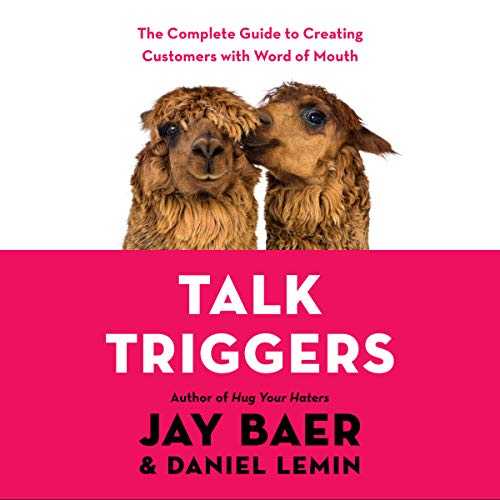Successful businesses have learned to tap into word-of-mouth marketing in the modern and highly competitive business landscape. To that end, I recently read the book “Talk Triggers” by Jay Baer. The book is based on his research into why and how customers talk about a product or service. The book provides a set of strategies that enable businesses to generate customer conversations about their product or services of their own volition. The book’s premise is that companies must be different and exceed consumer expectations in one or more ways to encourage customers to talk about their business to others. This is because consumers are hardwired to discuss what is different and ignore what is average. The book emphasizes the importance of giving customers something to tell a story about, which then becomes a ‘talk trigger’ that promotes word-of-mouth marketing.
Talk triggers are strategic differentiators that spark conversations naturally. These are not your typical marketing ploys but rather unique elements embedded in your business that customers can’t resist talking about. From exceptional customer service to quirky branding, the possibilities are endless.
Word-of-mouth marketing is one of the most potent tools in a business’s arsenal, so why settle for conventional marketing when you can leverage the innate power of word-of-mouth by creating talk triggers? Talk triggers naturally create buzz, turning customers into enthusiastic brand advocates. Imagine your business becoming the topic of animated discussions at social gatherings, both online and offline.
Implementing talk triggers for your business requires understanding your audience, recognizing what sets you apart, and infusing those distinctive elements into your customer experience.
4 Rs of Talk Triggers
Talk triggers revolve around four pivotal principles: Remarkable, Relevant, Repeatable, and Reasonable, collectively known as the 4 Rs. These principles create memorable experiences worthy of sharing.
- Remarkable: A talk trigger must stand out and be worthy of mention. It must be remarkable enough that customers naturally want to talk about it. It should be unique and memorable, prompting customers to share their experiences. Being remarkable makes your business stand out in a crowded market, creating a positive and lasting impression on customers. It sparks conversations and increases the likelihood of word-of-mouth marketing.
- Relevant: The talk trigger should be relevant to your business and align with your brand identity. It needs to make sense in the context of your products or services to ensure authenticity and coherence. Relevance ensures that the talk trigger doesn’t feel forced or disconnected from your products or services. It strengthens your brand message and helps customers understand the natural connection between the talk trigger and what your business represents.
- Repeatable: The talk trigger should be consistent and repeatable across various customer interactions. It’s not a one-time gimmick but a strategic recurring element embedded in your business that customers can come to expect. The repeatability of the talk trigger contributes to building a brand identity. Consistency reinforces the talk trigger’s association with your business, making it a reliable and integral part of the customer experience.
- Reasonable: The talk trigger should be reasonable for your business to sustain. It should be achievable and not place an undue burden on your resources. It should not strain company resources or create unrealistic expectations. Reasonability ensures that the talk trigger can be implemented and maintained over the long term. It prevents the talk trigger from burdening your operations and allows smooth integration into your business strategy.
Five Types of Talk Triggers
There are five types of talk triggers, which are distinctive elements businesses can strategically implement to generate word-of-mouth marketing. The five types are:
- Talkable Empathy: This type involves showing genuine care and empathy toward customers in a way that becomes a conversation starter. For example, a hotel provides a surprise care package for guests with personalized items based on their preferences.
- Talkable Usefulness: Businesses create talk triggers by offering a truly useful or unexpected service that customers find valuable. For example, a bank that provides a service allowing customers to instantly replace a lost or stolen credit card through their mobile app.
- Talkable Generosity: Businesses provide a level of generosity or over-the-top service that customers feel compelled to share with others. For example, a restaurant surprising customers with a complimentary dish or dessert, exceeding their expectations.
- Talkable Speed: This type focuses on delivering products or services with exceptional speed, creating a memorable experience. For example, an e-commerce company offers same-day delivery at no additional cost.
- Talkable Attitude: Businesses differentiate themselves by adopting a unique attitude or approach that customers find memorable and worth discussing. For example, an airline with a crew that injects humor and personality into safety announcements creates a positive and memorable experience for passengers.
Each type of talk trigger is designed to create a remarkable and shareable aspect of the customer experience, contributing to positive word-of-mouth marketing and setting the business apart from competitors.
Creating Talk Triggers in Six Steps
Embarking on the journey to creating an impactful talk trigger requires a strategic approach that goes beyond mere intuition. The process involves a series of deliberate steps aimed at understanding, engaging, and ultimately captivating your customers.
1. Gather Internal Insights
Before diving into creating a talk trigger, unlock what your business already knows about your customers. Explore who your customers are, what they want, and how they engage with your products or services. Unfortunately, word of mouth isn’t confined to just one department; everyone plays a role. So, gather insights from all corners if you have separate people in charge of marketing, sales, operations, and customer service. For specialist/freelancer businesses, you might be the sole source of knowledge.
2. Get Close to Your Customer
Understanding your customers is crucial. Market research and surveys can only reveal so much. Sure, they can rank what they want on a scale from 1 to 10, such as more speed, lower prices, faster processors, or more sandwich topping varieties, but rarely do they tell you what they really need. You must dive into their experiences with your products or services to create a talk trigger that truly surprises customers.
Find ways to answer questions like these:
- How do our customers experience our product or service?
- Why do our customers refer us today?
- What do our customers say about our brand, unaided?
- What do our customers say about our competitors or partners, unaided?
- At what point in the product/service experience should we introduce a talk trigger?
3. Create Candidate Talk Triggers
Coming up with a fun talk trigger idea is tempting, but working with intent is better. Answer the questions below as if you were the actual customer. Put yourself in their shoes. These questions unlock the value you created in the first two steps of creating a talk trigger:
- When I buy or use this product or service, I’m…
- What I don’t expect from this product or service…
- What I’m talking about in my life right now…
- What I want is…
- What I really want is…
Once you find an idea, it’s time for the next step: test and measure.
4. Test and Measure Your Talk Triggers
Don’t roll out a talk trigger without testing it first. Adopt a testing mindset to ensure it survives the initial phase. It has potential if it’s present in 10% of customer conversations during testing. However, it must be present in at least 25% of conversations for long-term viability. Testing and measuring ensure your talk trigger has the desired effect on customers.
5. Expand and Turn On
If your talk trigger passes the test above, the next step is to activate it. Even if customers love it, your colleagues and employees must be on board for it to succeed long-term. Stakeholders outside and inside your business all play a role in strategically turning on and activating your talk trigger. They could be employees, strategic partners, investors, suppliers, vendors, board members, or even other businesses in your community.
Once you’ve established a good activation fit, your final step is to amplify your talk trigger.
6. Amplify Your Talk Trigger
Your marketing mix is key to amplifying your talk trigger. Look for opportunities in advertising, social media, customer service responses, email campaigns, and your website. But don’t stop there; encourage employees to share the story and, if possible, make your talk trigger iconic for your company.
Talk Trigger Case Studies
Finally, we explore the following case studies of businesses successfully implementing talk triggers. From local startups to global enterprises, witness how these talk triggers have propelled them to the forefront of their industries. You can gain inspiration from their journeys and adapt their strategies to fit your unique business landscape.
The Coffee Shop Chronicles: Brewing Success with Personalized Service
In the heart of a bustling city, a quaint coffee shop decided to differentiate itself through personalized service. Each customer received a handcrafted beverage with a personalized note based on their preferences. The talk-worthy trigger? A simple yet powerful gesture that turned first-time visitors into loyal patrons and ignited a social media frenzy.
Related Post: How to Supercharge Word of Mouth
Tech Titan’s Quirky Innovation: Turning Users into Advocates
Instead of the usual press releases, a global tech giant sent out personalized, quirky packages to influencers and users. This unexpected approach generated a buzz that traditional marketing couldn’t match. Users shared their unboxing experiences on social media, creating a viral wave that increased product awareness and fostered a community of engaged users.
Related Posts: How to Get the Attention of an Influencer and How to Make Cold Calls That Will Get a Meeting with Important Prospects
A Boutique Hotel’s Secret Ingredient: Custom-Made Experiences
A boutique hotel in a tourist hotspot discovered the power of made-to-order experiences. They began surprising guests with personalized amenities based on their preferences and interests. From curated local experiences to customized room amenities, the hotel created an unforgettable stay for each guest. This trigger not only led to glowing reviews but also turned satisfied guests into enthusiastic storytellers, bringing in new bookings through word of mouth.
E-commerce Marvel: Unboxing the Element of Surprise
An e-commerce brand disrupted the online shopping experience by integrating a talk trigger into its packaging. Every customer received a surprise gift with their purchase, creating a sense of anticipation and delight. The unboxing experience became a moment to share on social media, turning ordinary deliveries into a brand celebration. This talk trigger not only increased customer loyalty but also attracted new customers eager to be a part of the excitement.
Related Post: What You Need to Know About Online Store Sales – The unboxing WOW effect
Restaurant Renaissance: Culinary Adventures Beyond the Menu
A restaurant in a competitive food scene stood out by introducing a “chef’s surprise” option, where diners could leave the choice of their main course to the chef. This element of surprise not only showcased the chef’s creativity but also created an engaging dining experience. Customers eagerly shared their culinary adventures on social media, making the restaurant a go-to destination for food enthusiasts seeking a unique dining experience.
Conclusion
In the dynamic landscape of modern business, the importance of harnessing the organic power of word-of-mouth marketing cannot be overstated. Jay Baer’s “Talk Triggers” unveils a strategic playbook for businesses that are eager not only to meet customer expectations but to exceed them, prompting organic conversations about their products or services.
The 4 Rs, Remarkable, Relevant, Repeatable, and Reasonable, emerge as the guiding principles, emphasizing the need for distinctive, consistent, and practical talk triggers. Talk triggers are categorized into five types: Empathy, Usefulness, Generosity, Speed, and Attitude and serve as catalysts for authentic and shareable customer experiences. Finally, implementing talk triggers involves a meticulous six-step process.
As your business embarks on the journey of creating its own talk triggers, the key lies in understanding your audience, identifying what sets them apart, and seamlessly integrating these distinctive elements into the customer experience.
In a world inundated with marketing noise, talk triggers offer a refreshing and effective approach, turning customers into enthusiastic brand advocates and ensuring businesses not only stand out but thrive in the realm of genuine customer conversations. So, let the power of word of mouth be your ally, and may your talk triggers become the talk of the town, both online and offline.
What Is Your Talk Trigger?












